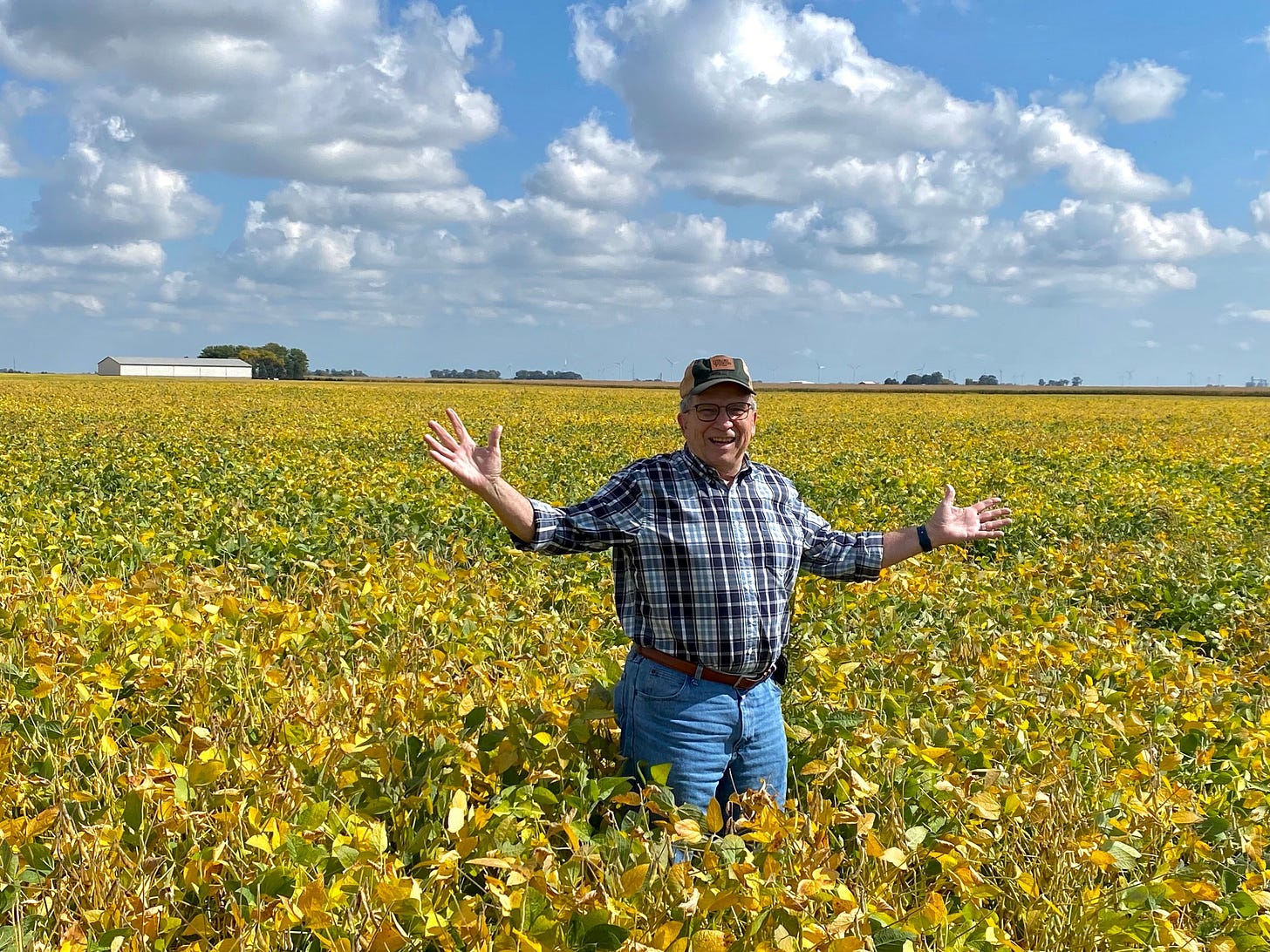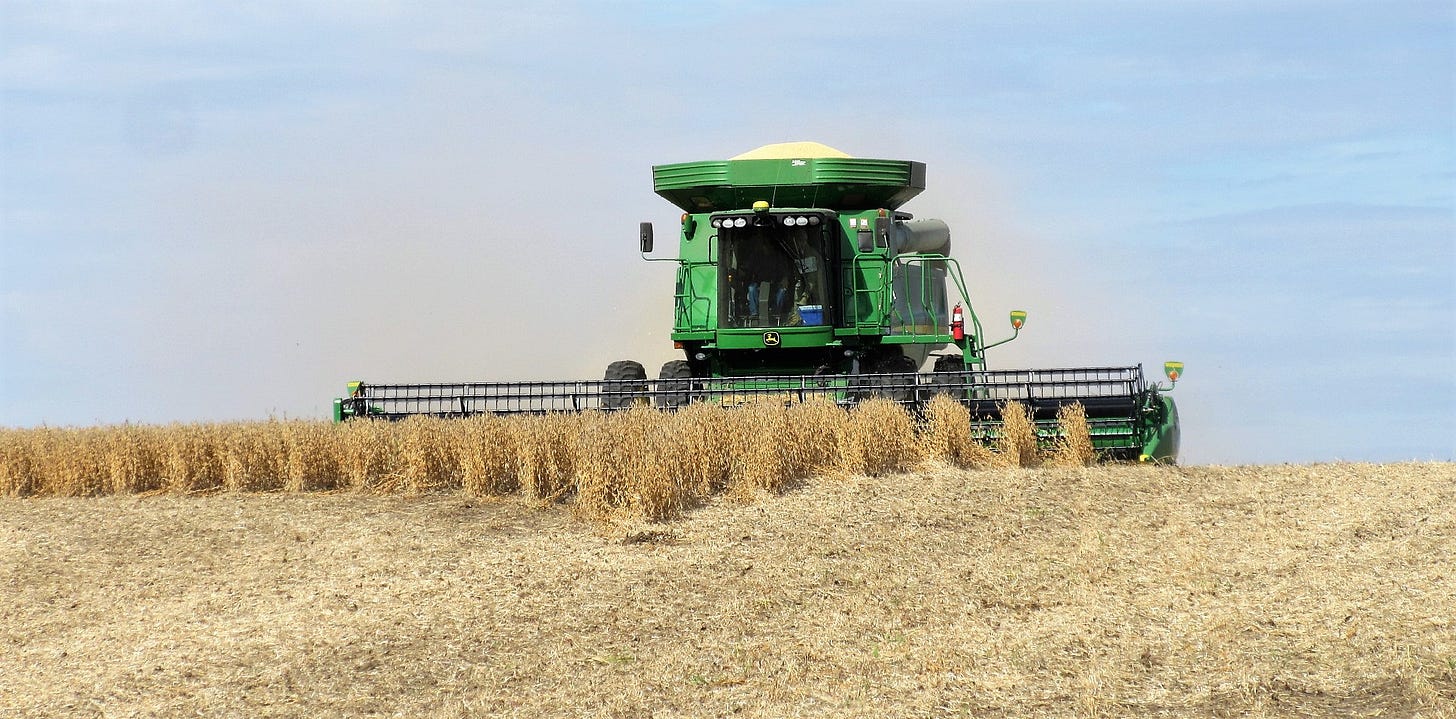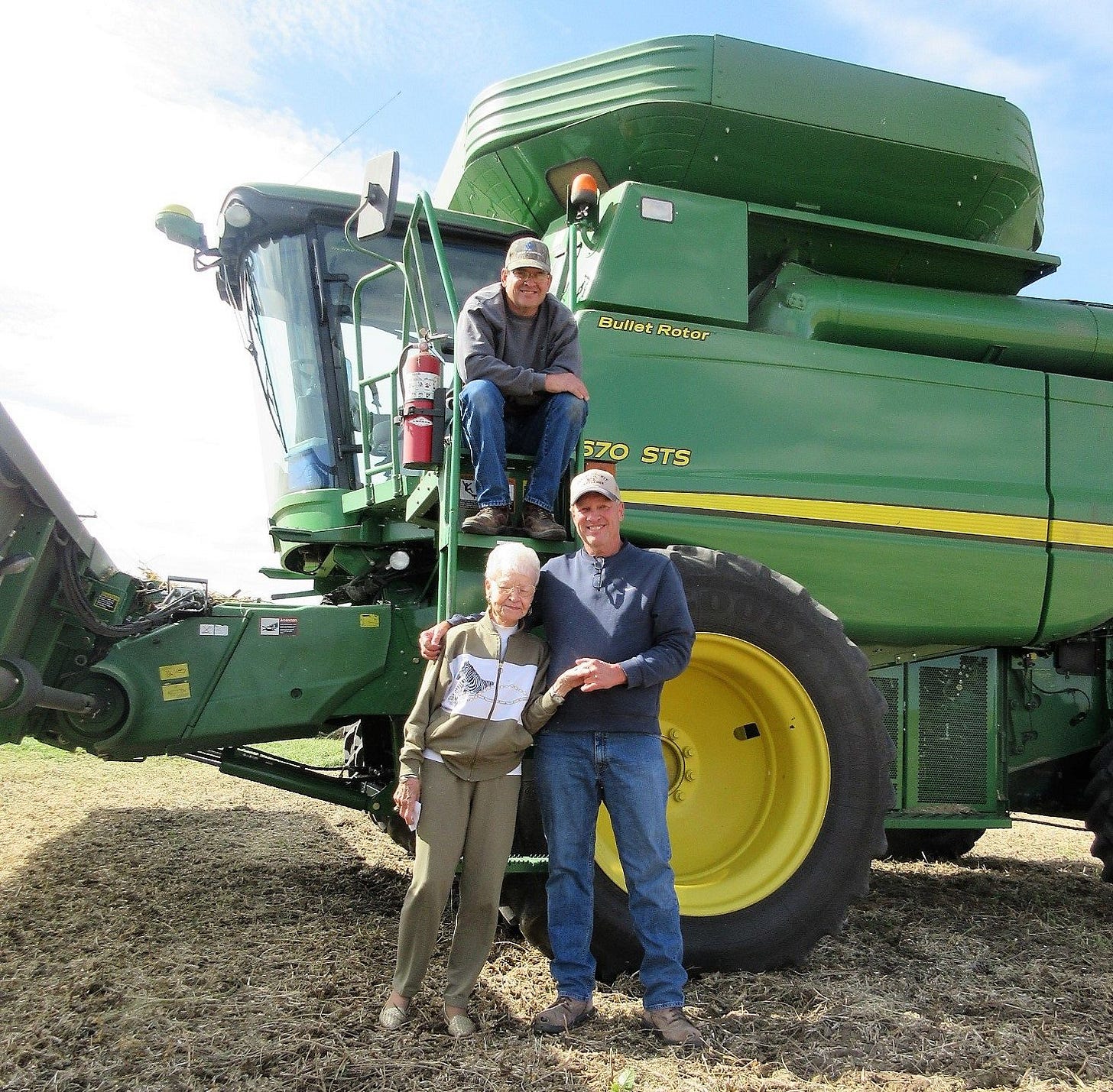JEFFERSON, Iowa – For the first time in 19 years, I am not living in the Iowa countryside as the harvest begins.
Yes, my frequent road trips are still giving me plenty of up-close views of harvest progress.
But I’m feeling a little more like a spectator now and a little less like a participant, even though I’ve never been directly involved – like actually working out there.
I grew up a town kid in Shenandoah in southwest Iowa. Several of my best friends were farm kids, but I’m ashamed now how little I knew back then about what their lives and farming operations were really like.
In the 1970s, when I started traveling the state for my Des Moines Register stories and columns, I had to learn agriculture in a hurry.
A stop last week in a soybean field in northern Greene County, Iowa. (Photo by Mary Riche)
I made many phone calls back home to Bruce Ketcham and Jim O’Hara, pals since we were boys who stayed on their farms for careers. I would pester them with all kinds of questions about what I was seeing and hearing. Uh, tell me again, what’s the difference between a calf, a heifer, a cow and a steer? Are Poland China pigs from Poland or China, and how’d they get here? And, one more time, how is it that the grain futures market works?
Ah, those wild ag markets!
In 1990, I ran into hog farmer Dan Peterson when I was back in Shenandoah for a weekend. “I’ve got 50 beautiful sows,” he said, when I asked how things were going. “At least that’s what I’ve been calling them lately, because if you follow the markets at all, you know they’re worth good money right now. There’ve been other times I’ve called them 50 filthy bitches.”
A LOT OF CHARACTERS, FOR SURE. I have indeed met some grand characters and colorful talkers who have guided my farm studies.
Another of those was the late Dale Edwards, a farmer from Audubon in southwest Iowa, who became part of my “panel of experts,” sort of a not-so-grand jury, that I’d meet with periodically at Sam’s Barber Shop in that town. I’d ask questions about big issues, little issues, trends, politics, business, farming and more, and then I’d report their insights to my Register readers.
Farmer Dale had the whole state buzzing when he explained how he determined when to start planting corn each springtime. “When you can walk out in the field, pull your pants down, sit down butt-naked and be comfortable sitting there,” he said, “then it’s time to plant corn.” That got him in the Chicago Tribune, too!
Then there was Alan Henderson, who farmed outside Milton in southeast Iowa. In 1995, I had talked Alan and his wife Brenda Henderson, bicycle riders, into getting their crops planted and then going on a trans-USA bicycle ride with me and 300 others to promote the upcoming Iowa Sesquicentennial celebration. In a normal weather year, the Hendersons would’ve been done planting their crops by mid-May, but that springtime turned out to be very wet and chilly, and they had almost none of their fields done on Memorial Day weekend, when it was time to start our bike ride in California.
Their two sons in high school, Travis and Art Henderson, said they could handle the planting, and they did – almost all of it. But about three weeks later, it became clear to them that they’d totally forgotten one small patch of a dozen or so acres. When they realized they’d missed it, they called their parents at one of our overnight campgrounds Out West. Alan took the call on a pay phone (remember those?), listened, started shaking his head, and then asked the question that drives how lots of Iowa farm problems are resolved: “Well, tell me this,” he said to his sons, “can you see it from the road?”
MY FIRST AND ONLY TIME DRIVING A COMBINE. My most memorable harvest experiences started, I think, one autumn in the mid to late 1980s.
As I saw combines begin working cornfields that fall, I moaned in one of my columns about how I didn’t feel like a real Iowan because I’d never harvested corn. That brought a call from a friend Paul Johnson, of Pomeroy in northwest Iowa, who owned a Phillips 66 gas station, which was as much of a hangout as it was a fuel point.
“I was just talking to Glen Hanson up here about your column, and we can help you with that problem of never having harvested corn,” Johnson said. “He and his brother Gary farm together, and they’re going to hold several rows of corn until you can get up here and run their combine.”
I was so excited, I was there by the end of that week. With Glen Hanson sitting beside me in the cab of the big combine, I made a nice run east through a field. I was thrilled watching the gauges measuring how much grain I had filling the hopper. But then when I had to turn around for the run back west, big problem!
With my starting, stopping, turning a little, backing up, turning some more, going forward, backing up again, I wiped out a whole wide swath of cornstalks, leaving who knows how many ears of corn on the ground. I was embarrassed, and Glen Hanson was grinning. And, ultimately, I probably made the deer happy.
THE MOVE TO THE MIDDLE OF IT ALL. In 2004, I moved to an acreage outside little Cooper in Greene County in west central Iowa, and lived most of the next two decades in a completely rural neighborhood. My farm neighbors Doug and Karen Lawton became my best friends and most reliable ag interpreters.
Doug taught me how to tell when soybeans are ready for harvest. “You pick a pod, open it up and pop a couple of the beans in your mouth,” he said. “If they are just a little crunchy when you’re chewing them, they’re about ready to go.”
When we were battling cancer at my house, Karen just added “Offenburgers” to their meal list for their harvest and planting crews, and delivered to us.
In long conversations with the Lawtons, and lots of questions for them, my knowledge and appreciation of agriculture really grew. They’d patiently explain and answer, only occasionally rolling their eyes.
“When you’re just starting into your first soybean field at harvest time,” I once asked Doug, “do you ever stop and maybe say a little prayer? Or read a poem? Or maybe do some other kind of meditation?”
“No,” he said.
“Well,” I said, “would you, if I found a poem?”
“I don’t think Tom will sit still for that,” Doug said. He and his first cousin Tom Lawton each head their own farming operations, but at planting and harvest times, they share equipment and work together with their wives, kids and other relatives.
The Lawtons combining soybeans.
I begged for an opportunity to do the poem.
Just give me an hour’s notice when you’re going to start the harvest, I told the Lawtons, and I’ll meet you at the soybean field of your choice. I promised to bring a poem by my friend Michael Carey, the “farmer poet” who is an Iowa Writers Workshop graduate, nationally known for his verse, and for several years a farmer outside Shenandoah.
Surprisingly, the call came one midday, I grabbed my book of Carey poems and drove to the designated field. Tom was waiting with the combine, and Doug drove up in a semi-trailer truck for grain hauling. I made them both turn off the engines and stand out in front of the combine. And then I read a Carey poem about the way the big machines shake the earth during the harvest. They listened politely, fidgeted only a little, then jumped into the combine and truck, and started the real work.
I wrote and posted a column and photos about that experience. Imagine my satisfaction a couple days later when Tom Lawton’s landlords called him from California and told him how wonderful they thought it was that he began the harvest with a little ceremony and poem!
PAYING HOMAGE TO A LOCAL FARM LEGEND. In the fall of 2017, I was bugging the Lawtons with another unusual request.
We at the Greene County Historical Society in Jefferson had learned that from the 1950s to the 1970s, Alma Shorey Young had been the general manager of the grain elevators in Jefferson and two or three smaller towns in the county. She was apparently the only woman running a grain co-op in the nation, a distinction that had barely been celebrated back then and was mostly forgotten.
We began making calls to see if we could locate her, and we did – then 91 years old and living in a retirement center in Mountain Home, Ark. She agreed she’d make a trip back to Greene County in early October to tell her story in a program for the historical society, visit the huge Landus Cooperative elevator of today, and “to see one more harvest.”
The team at Landus treated her like a celebrity. And the Lawtons graciously helped her climb up into the cab of their combine and ride along as they harvested soybeans in the same Greenbrier Township neighborhood when Alma had spent part of her girlhood. It was one of my favorite farm days ever.
Alma Shorey Young, ready to join the Lawton cousins in combining soybeans in October of 2017. That’s Tom Lawton on the steps and Doug Lawton with Alma.
WHAT IT’S LIKE OUT THERE TODAY. In my almost two decades living in the Greene County countryside, agriculture really changed.
In that time period, mostly within a couple miles of my place:
—I watched Shriver Farms, one of Iowa’s largest organic operators, grow to more than 2,000 acres.
—The local livestock industry has been born again, after 20 years earlier moving away to the southwestern states.
—Four bio-fuels plants have been built around the county.
—We can now look to the horizon and see more than 120 wind turbines generating electricity.
—NEW Cooperative is just completing construction on a sprawling new grain elevator and feed mill, which likely is the largest and most expensive construction project in county history.
—And we start this harvest season with corn nearly $6.50 per bushel and soybeans better than $13.50 per bushel, which are strong prices.
I’ve had a lot of wonder and no little pride seeing it happen. I’ve become a cheerleader for Iowa farmers.
These people are bold entrepreneurs, innovators, risk takers, daredevils. They are technology geeks, biologists, agronomists, engineers and mechanics. They know more beauty and nature than most of the rest of us can imagine. And most are really hooked on what they’re doing.
About 30 years ago, I was in a noon-hour meeting of an organization in the board room of a big Des Moines business. As people were drifting in and chatting before the start of the meeting, I overheard a young woman I did not know remark on what a beautiful autumn day we were having.
“This time of year on days like this,” she said, “I just want to be back home in Greene County, getting on one of those big machines and being part of the harvest.”
I found out later she was Chris Henning. She eventually followed that instinct, made the move home, bought a farm, and has been one of my neighbors.
And I finally understand exactly what she was talking about that long ago day in Des Moines.
--
You can write me by commenting below here, or by direct email to me at chuck@offenburger.com.
--
AN OPPORTUNITY FOR YOU READERS: Julie Gammack, the veteran Iowa journalist, radio talk show host and organizer of good causes, has summoned a group of – so far – 13 of us who are well-known Iowa writers from a variety of backgrounds, experiences and locations. We’re scattered across the state.
The 13 of us now are Gammack, Art Cullen, Mary Swander, Laura Belin, Doug Burns, Dave Busiek, Bob Leonard, Debra Engle, Ed Tibbetts, Dana James, Beth Hoffman, Suzanna de Baca and me.
We are now all members of the “Iowa Writers Collaborative,” and we’re sharing much of our new work on the “Substack” online platform.
Please consider “subscribing” to receive our individual columns. If you do, you’ll receive our new columns via email. That subscription, by the way, is free if you want it to be. Or you can pay a very modest monthly or yearly fee to us individually. Or you can make more substantial donations to us. Your choice.
Mostly, we all appreciate your readership, feedback, sharing and your ideas for more columns by each of us.
Here’s where you can find us and learn more about this offering:
Laura Belin: Iowa Politics with Laura Belin
Doug Burns: The Iowa Mercury
Dave Busiek: Dave Busiek on Media
Art Cullen: Art Cullen’s Notebook
Suzanna de Baca: Dispatches from the Heartland
Debra Engle: A Whole New World
Julie Gammack: Julie Gammack’s Iowa Potluck
Beth Hoffman: In the Dirt
Dana James: New Black Iowa
Robert Leonard: Deep Midwest: Politics and Culture
Chuck Offenburger: Iowa Boy Chuck Offenburger
Mary Swander: Mary Swander’s Buggy Land
Ed Tibbetts: Along the Mississippi
Iowa Writers Collaborative: Iowa Writers Collaborative







really enjoyed this column about farming. Enjoyed the humor interwoven into it. It adds a great deal of spice I think to life when we remember our humor in life. I have always been a city girl but did pull weeds from a bean field one day while being in high school and living in nevada, iowa. I got paid the grand sum of a buck an hour and they fed us well. They picked us up and delivered us back home riding in the back of a pickup truck. I swear I dreamed I was pulling weeds from that field all night long. It was probably the best kind of tired I have ever been in my life. L. Quinnett
I became emotional reading this column. It is the first time I have read something you've written since your time writing for the Des Moines Register.
I have always had a few relatives who farmed in Hamilton county. I used to stay with them for a week or two in the Summer and I have the best memories from those times. I love being in the country.
Thank you for reawakening my memories, and for being the guy who understands who farmers are, and can help others understand them.